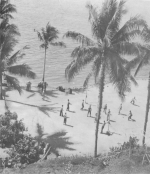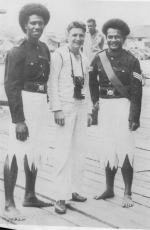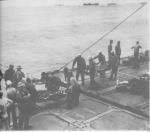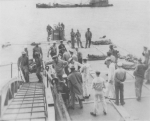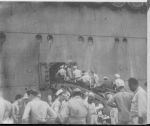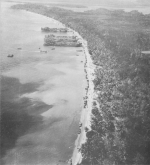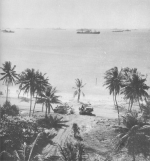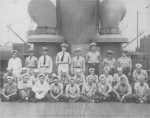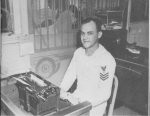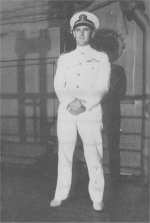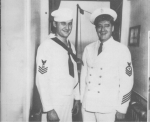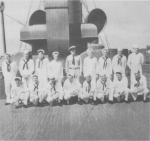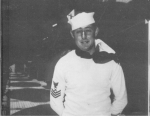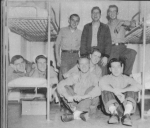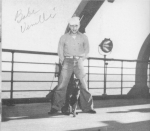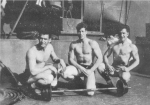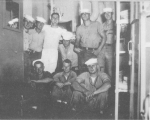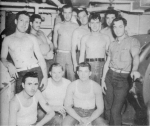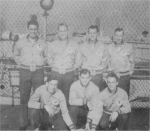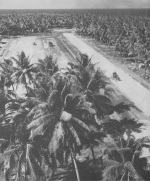Please report any broken links or trouble you might come across to the Webmaster. Please take a moment to let us know so that we can correct any problems and make your visit as enjoyable and as informative as possible.
NavSource Online: Service Ship Photo Archive
AP-22 Mount Vernon
Cruise Book 1941 to 1946
Page 6Contributed by Robert E. Houle, CM2c, SSMT1c
All images in this section are taken from the cruise book. Narrative has been transposed and added to the photos where appropriate.
Click on Thumbnail Image to See Enlarged Picture
"Advertisements call the Hawaiian Islands the Paradise of the Pacific, and the crew watched with eagerness the dim gray blur on the horizon change into colorful mountains of Oahu. Famed Diamond Head excited comments. The sweep of Waikiki Beach, the Royal Hawaiian hotel, the shops and the residents shifted into view as the ship moved on toward Pearl Harbor. Already past the Punch Bowl, the ship suddenly received the word, 'Dock in Honolulu.'
The usual greetings of Aloha was missing. There were no bands to play, no leis were offered for sale.
The business section of the city was attractive. The buildings were a varied architectural style, but all were planned to keep interiors cool. Leaving the immediate business section, the change to poverty was so abrupt that it was shocking. The oriental section was even more shabby. Farther out toward Diamond Head, Waikiki Beach, the mecca of wealthy tourists, contained more elaborate homes and shops.
In the transition area there were shops catering to sailors filled with cheap souvenirs. They were packed with crowds that did not purchase. Disgusted, the owners harked their wares as the crowds looked bored and walked on into the streets.
At Waikiki Beach, everyone was disappointed in what was one of the famous beaches in the world. To keep from cutting their feet on the coral washed up on the beach it was necessary for the swimmers to wear sandals. However, the men had their pictures taken there in order to have the background of Diamond Head.
In the shops along the beach road and on the streets the women wore red or white hibiscus behind their ears and in their hair. Rationing was unheard of in the islands--except for whiskey.
The Royal Hawaiian hotel, having been turned over to the Navy, was enjoyed by the men. The tropical setting of the gardens, badminton and tennis courts made playing more enjoyable.
Near the Y.M.C.A. busses were loaded for the Pali pass and the other side of the island. Up a winding road past palatial mansions, by the Hawaiian Water Reservoir, by the upside down water fall, through a jungle, the bus suddenly came to an opening at the top of the knife-like ridge that bisected the island. The earth seemed to drop away. Several hundred feet below, the floor of the valley stretched out to accommodate cane fields, papaya groves, and banana plantations.
Hairpin curves took the bus down through the valley and to the beach. The Beach USO provided a recreation center with dressing room facilities. The surf was ideal for all types of water sports; shoes were not necessary. The beach floor was smooth and level.
Pearl Harbor, a large bay with many coves, was filled with activity as ships were repaired, refueled, fitted out, and countless other tasks were completed necessary for keeping the vessels at sea. Remnants of the Jap attack were still visible.
Nature hid the stern mountains of the FIJI ISLANDS under a lush blanket of undergrowth and jungle. Surrounding the shore line were long treacherous coral reefs requiring expert navigation of incoming ships.
Here, the crew of the 'Mount Vernon' found an Army bivouac, a Naval Supply Base, and a hospital--but no city. A few native huts were scattered about; a few Army tents dotted the area; several storehouses indicated some form of activity.
Taking of photographs was permitted. Suddenly, many cameras appeared that had not been seen before. Everyone tried to get his picture standing with the Fuzzy-Wuzzy policemen. Wearing dark shirts and pure white scalloped lava lavas, the barefoot police created a sensation.
Patients evacuated from the advance battle areas to the Fiji hospital were transferred aboard. The facilities for care of the patients were comparable to any hospital ship's. Under the direction of Dr. Tabeer, the medical department had been organized Under Dr. Jostes' direction, it had been enlarged and improved. A new operating room had replaced the 'board-on-bathtub' apparatus formerly in use.
From Fiji to San Francisco, these patients had uninterrupted medical care.
Palm trees and jungle along the beach against the backdrop of mist covered mountains rising high in the distance gave the New Guinea coast a forbidding but almost ethereal appearance. The ship entered Milne Bay with caution as charts and navigational aids along the [New] Guinea coast were many times inaccurate. During the stay, however, evidence of the real characteristics of the country became apparent. Beyond the sand beaches was mud and boiling humidity of the air with the constant danger of malaria and fungus infections in the jungle. Troops were debarked on the beach and the ship steamed away from the area. Fortunately, the stay had not been a long one.
Following the sweeping curve around the island mountain guarding the entrance of the Auckland Bay, the outskirts of the city could be seen. Woods grew in clusters between residential areas, and reached down to the swimming beaches.The Grecian architecture of the Art Museum belonged on the hillside overlooking the bay, and the graceful arches of a bridge ended near Victoria [P]ark. There was the city. The brick houses tight against each other, covered the hills, their countless chimney pots giving Auckland a domestic and homey atmosphere. Docking by the ferry building with its tall clock tower, the crew of the 'Mount Vernon' found themselves strategically located at the foot of the city's principal thoroughfare.
The Shops were crowed together suggesting genteel poverty. Elizabeth street branched to from a 'Y', and to the right the King's Place theater was next to the roller skating rink where the 'Mount Vernon' boys were to be found.
Purchasing greenstone rings, and the Maori Ticki (their good luck charm) carved boxes and other articles made from para shells, the crew found the shop keepers showing the half penny with the Maori Ticki embossed on it. Those cut out, made bracelet charms.
Several of the many restaurants were serving the evening meal. A five course dinner could be purchased for thirty-five cents. The waitresses always asked the sailors if they wanted lettuce and tomato. Dessert and beverage always came extra.
The room space in all shops was small. The restaurants were crowed with minute tables, and the waitresses had to do a great deal of careful maneuvering. Carrying their trays of steak and eggs or fish and chips, they looked in complete bewilderment at the food desires of the Americans.
'The best place to get coffee is the American Bar' was the word whispered around, and all hands managed a stop there before returning to the ship.
Movie theaters 'booked' each performance. Each show was scheduled and shown as if it were a stage production. The short subjects came first, then the 'interval' during which tea, coffee, ice cream and biscuits were sold. Then the picture. The streets were packed for the next half hour as the downtowners hurried to catch the 'last tram' home.
At the dance hall in Albert's Park could be found the men of the ship. Tours out to Mount Eden, an extinct volcano, were made by tram or bus. The town across the bay attracted many, but the ferry trip caused most of the men to remain in the Auckland area.
Alone, the lighthouse stood guard at the edge of the reef. Ships came close aboard, made a sharp turn and slid between coral [shelves]. The mountains were high and blue in the distance, but the hills at the harbor's edge were barren. Noumea, looking like a mining camp, was at the head of Dumbea Bay.
During peace, the Clippers halted here, but with the world at war, countless Allied ships lay at anchor, refueling, taking on supplies, or giving the men a chance to set foot on solid earth after months at sea.
Noumea had little to offer for entertainment. Bars were shambles, hastily thrown together. Good liquor was served for the first two or three drinks, and then it was exchanged for inferior brands."
The huge Tonganese soldiers watched the long line of 'Yanks' against the wall surrounding the Pink Palace. The souvenirs were not products of Noumea, but they were purchased by the Americans: wood carving from the Tonga Island[s] and trinkets from the South Sea Curio Company. At the Army PX attractive French girls served coffee, malted milks, ice cream, or sandwiches. Officers spent their time at the Officers' Club in the Hotel Pacific.
The view of the city from St. Joseph Cathedral was excellent, lying spread under the billowing clouds of yellow smoke from the nickel smelters.
Javanese women with their wrap-around skirts and immense straw hats moved quietly among the cosmopolitan crowds of Chinese, Tonganese, British, American, and French natives.
Water snakes and fungus infection resulted in the cancellation of swimming. Hunting parties were arranged when the time permitted.
Chief Specialist Jerome Zebre, Cafe Society photographer, was assigned to the ship, reporting aboard the night before sailing. Preparing to retire, Zerbe donned a pair of bright pink pajamas. About 0200 Johnson, CWT, came aboard from liberty. Turning on the light he saw Zerbe blissfully asleep. Johnson was panic stricken. When he could control his laughter he led the Officer of the Deck in and pointed to Zerbe. Next he showed the sleeper to all the messengers and to the men returning from liberty, until the OOD had to send Johnson to bed. Later, when the ceremony of crossing the line was in progress, Zerbe was required to parade round the ship in the pinkies.
With the arrival in New Caledonia in 1943, the ship was called upon to furnish replacements for Admiral Halsey's fleet. Almost three quarter of the deck force was transferred. Shortly after, a new draft reported aboard in San Francisco. fortunately, conditions were not as bad this time as they had been when the commissioning crew took over in Philadelphia, for there remained a nucleus of the experienced personnel.
Several of the men who came aboard as seamen in the first draft of 1942 had become responsible petty officers. There was Villanelli, who took over the reins of the First division in 1943 and remained in charge until he was made chief in the fall of 1945. In the Second division 'Smiley' Witter and 'Red' Clifton were given charge of the division.
The Transportation division, working with the permanent Army staff aboard, was responsible for the handling and caring for the six thousand passengers. It insured proper berthing and messing schedules, and maintained cleanliness in the troop living spaces. One of the few larger transports to do so, the 'Mount Vernon' served three meals each day to all passengers, a total of nearly 20,000 meals daily--over eighteen tons of food!"
This page is created and maintained by Gary P. Priolo

|
